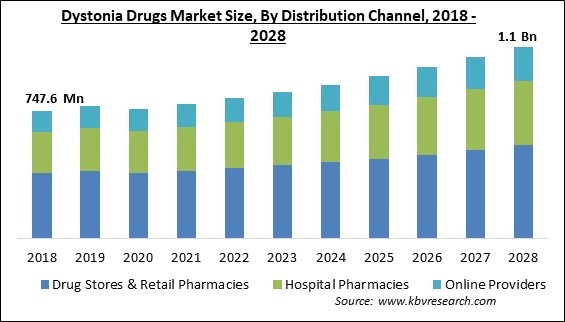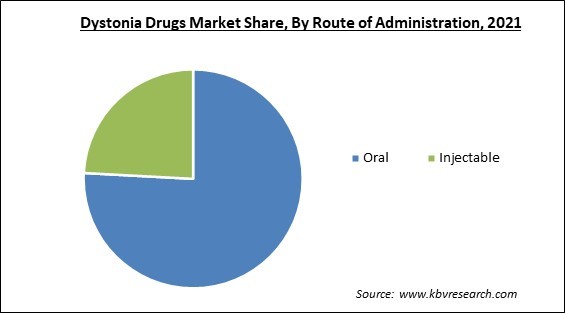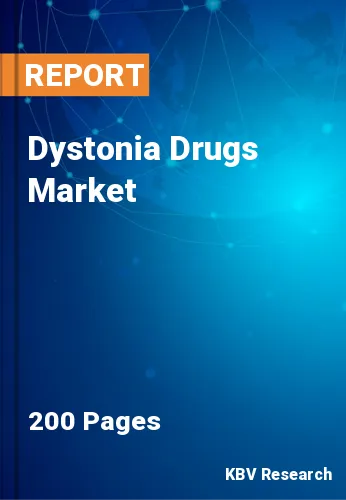The Global Dystonia Drugs Market size is expected to reach $1.1 billion by 2028, rising at a market growth of 5.4% CAGR during the forecast period.
Dystonia is a movement disease characterized by involuntary muscle contractions that lead to repetitive sluggish motions or aberrant postures. This muscle contraction results in aberrant muscle motions and body positions. Various types of dystonia can affect a single muscle, a group of muscles, or all of the body's muscles. It is caused by illnesses such as brain injury at or around birth, certain infections, brain trauma, and other vascular abnormalities, including stroke, arteriovenous, and others.

Patients may experience unpleasant movements or tremors as a result. There is no specific treatment for dystonia. However, its symptoms can be alleviated with various drugs. Uncontrollable muscular contractions characterize the neurological movement disorder dystonia. It is a condition that has no age, ethnic, or racial borders; it can afflict children and people of all races and ethnicities from infancy to old age.
Dystonia is caused by faulty basal ganglia functioning, a deep brain region that controls movement coordination. These brain regions regulate the speed and fluidity of movement and avoid undesired motions. Dystonic patients may exhibit involuntary twisting, repeated motions, or aberrant postures and positions. This includes the arms, legs, trunk, face, and vocal cords.
The origin of dystonia is unknown, but it may entail alterations in many brain regions or their connectivity. Dystonia may be genetic, acquired, or idiopathic in origin (no known cause). Inherited illnesses are genetically transmitted. In acquired forms, dystonia is caused by brain damage or degeneration (e.g., following a brain injury or stroke) or drug exposure. There is no known cause and no anatomical injury or degeneration of the brain in idiopathic dystonia.
The outbreak of COVID-19 has affected operations in the healthcare sector. Several industries, including various sub-domains of health care, have been forced to close temporarily due to COVID-19. In 2020, the market for dystonia drugs declined due to the economic slowdown triggered by COVID-19. Furthermore, COVID-19 impacted the supply chain in businesses such as healthcare, further restricting the market growth. However, with ease in the pandemic, businesses and supply chains are returning to normal, which is expected to aid the market in recovery.
The federal government influences private spending on research and development through programs that increase the demand for prescription drugs, through policies (like spending for basic research and regulations on what must be demonstrated in clinical trials) that affect the supply of new medicines, and through policies (like vaccine recommendations) that affect both supply and demand. The growing R&D in the pharmaceutical industry globally is expected to enhance the effectiveness of dystonia drugs and their utilization, thereby boosting the market growth.
According to new research from the World Health Organization (WHO), neurological illnesses impact up to one billion people globally. Neurological diseases impact individuals in all nations, regardless of age, gender, level of education, or money. Around 6.8 million people die annually due to neurological illnesses. Access to adequate care is challenging for many individuals with neurological illnesses, their families, and care providers. Primary health care is the only access to medical care for many individuals. Despite the availability of highly effective, inexpensive medications, many people with neurological disorders remain untreated. Health systems must be fortified to provide better treatment for individuals with neurological illnesses.

According to new research from the World Bank and the World Health Organization, at least half of the population lacks access to crucial health care. And each year, many households are forced into poverty because they must pay for their health care. Nowadays, 800 million people spend at least 10 percent of their household budgets on health-related expenses for themselves, a sick kid, or another family member. These costs are sufficient to force about 100 million people into extreme poverty, requiring them to live on $1.90 or less per day.
Based on type, the dystonia drugs market is segmented into anticonvulsants drugs, GABAergic agents, dopaminergic agents and others. The GABAergic agents segment dominated the dystonia drugs market with maximum revenue share in 2021. The growth is attributed to its benefits in treating dystonia, particularly cervical dystonia. In addition, the discovery of highly effective and potent GABAergic agent pharmaceuticals for treating dystonia, combined with its more comprehensive prescription by healthcare experts, is fueling the segment's expansion in the forecasted period.
On the basis of route of administration, the dystonia drugs market is divided into oral and injectable. The injectable segment procured a substantial revenue share in the dystonia drugs market in 2021. This is because of the rise in innovations in parenteral dosing and increased research and development for botulinum injections. Absorption of the medication, especially aqueous solutions, is rapid and uniform. There is a rapid commencement of effect compared to the oral and subcutaneous methods. Injection intramuscularly bypasses the drug's first-pass metabolism.
By distribution channel, the dystonia drugs market is classified into hospital pharmacies, online providers and drug stores & retail pharmacies. The drug stores & retail pharmacies segment witnessed the largest revenue share in the dystonia drugs market in 2021. This is due to its extensive chain of distribution networks and it being the oldest and most convenient channel for providing drugs to consumers. Retail pharmacists prepare and dispense drugs, counsel consumers on the proper use of medications, and inform them of potential drug interactions. Also, retail pharmacists advise clients regarding over-the-counter medications and general health concerns.
| Report Attribute | Details |
|---|---|
| Market size value in 2021 | USD 784.3 Million |
| Market size forecast in 2028 | USD 1.1 Billion |
| Base Year | 2021 |
| Historical Period | 2018 to 2020 |
| Forecast Period | 2022 to 2028 |
| Revenue Growth Rate | CAGR of 5.4% from 2022 to 2028 |
| Number of Pages | 200 |
| Number of Table | 350 |
| Report coverage | Market Trends, Revenue Estimation and Forecast, Segmentation Analysis, Regional and Country Breakdown, Companies Strategic Developments, Company Profiling |
| Segments covered | Distribution Channel, Route of Administration, Type, Region |
| Country scope | US, Canada, Mexico, Germany, UK, France, Russia, Spain, Italy, China, Japan, India, South Korea, Singapore, Malaysia, Brazil, Argentina, UAE, Saudi Arabia, South Africa, Nigeria |
| Growth Drivers |
|
| Restraints |
|
Region-wise, the dystonia drugs market is analyzed across North America, Europe, Asia Pacific, and LAMEA. The North America region generated the highest revenue share in the dystonia drugs market in 2021. This is because of the growing occurrences of dystonia and the rise in the prevalence of other neurological disorders that cause dystonia in the population. In addition, the presence of a well-established healthcare infrastructure, a high purchasing power, and an increase in the diagnosis and treatment of dystonia in the region. The presence of a large number of unmet healthcare demands and a favorable regulatory environment are projected to boost the market's expansion.
Free Valuable Insights: Global Dystonia Drugs Market size to reach USD 1.1 Billion by 2028
The market research report covers the analysis of key stake holders of the market. Key companies profiled in the report include Pfizer, Inc., Novartis AG, Teva Pharmaceuticals Industries Ltd., AbbVie, Inc., F. Hoffmann-La Roche Ltd., Ipsen Pharma Biotech SAS, Hameln Pharma Gmbh (Siegfried Group, LLP), Amneal Pharmaceuticals, Inc., Merz Pharma GmbH & Co. KGaA, and Wellona Pharma.
By Distribution Channel
By Route of Administration
By Type
By Geography
The global Dystonia Drugs Market size is expected to reach $1.1 billion by 2028.
Enhancement of pharmaceutical research and development are driving the market in coming years, however, Vast amount of the population unable to receive necessary medical care restraints the growth of the market.
Pfizer, Inc., Novartis AG, Teva Pharmaceuticals Industries Ltd., AbbVie, Inc., F. Hoffmann-La Roche Ltd., Ipsen Pharma Biotech SAS, Hameln Pharma Gmbh (Siegfried Group, LLP), Amneal Pharmaceuticals, Inc., Merz Pharma GmbH & Co. KGaA, and Wellona Pharma.
The expected CAGR of the Dystonia Drugs Market is 5.4% from 2022 to 2028.
The Oral segment acquired maximum revenue share in the Global Dystonia Drugs Market by Route of Administration in 2021 thereby, achieving a market value of $837.3 Million by 2028.
The North America market dominated the Global Dystonia Drugs Market by Region in 2021, and would continue to be a dominant market till 2028; thereby, achieving a market value of $432 Million by 2028.
Our team of dedicated experts can provide you with attractive expansion opportunities for your business.

